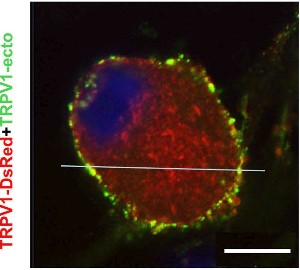Overview
- Peptide (C)NSLPMESTPHK(S)RGS, corresponding to amino acid residues 605-619 of rat TRPV1 (Accession O35433). 3rd extracellular loop.

Won't recognize TRPV1 from human samples.
 Western blot analysis of TRPV1 in rat DRG:1. Anti-TRPV1 (VR1) (extracellular) Antibody (#ACC-029), (1:200).
Western blot analysis of TRPV1 in rat DRG:1. Anti-TRPV1 (VR1) (extracellular) Antibody (#ACC-029), (1:200).
2. Anti-TRPV1 (VR1) (extracellular) Antibody, preincubated with TRPV1/VR1 (extracellular) Blocking Peptide (#BLP-CC029). Western blot analysis of mouse BV-2 microglia cell line lysate (lanes 1 and 4), mouse TK-1 T-cell lymphoma cell line lysate (lanes 2 and 5) and mouse P815 mastocytoma cell line lysate (lanes 3 and 6):1-3. Anti-TRPV1 (VR1) (extracellular) Antibody (#ACC-029), (1:200).
Western blot analysis of mouse BV-2 microglia cell line lysate (lanes 1 and 4), mouse TK-1 T-cell lymphoma cell line lysate (lanes 2 and 5) and mouse P815 mastocytoma cell line lysate (lanes 3 and 6):1-3. Anti-TRPV1 (VR1) (extracellular) Antibody (#ACC-029), (1:200).
4-6. Anti-TRPV1 (VR1) (extracellular) Antibody, preincubated with TRPV1 (VR1) (extracellular) Blocking Peptide (#BLP-CC029).
 Expression of TRPV1 in rat DRGImmunohistochemical staining of rat dorsal root ganglion (DRG) frozen sections using Anti-TRPV1 (VR1) (extracellular) Antibody (#ACC-029), (1:100) followed by goat anti-rabbit-ATTO Fluor-594 secondary antibody (red). TRPV1 is expressed in medium and small DRG neurons. Hoechst 33342 is used as the counterstain (blue).
Expression of TRPV1 in rat DRGImmunohistochemical staining of rat dorsal root ganglion (DRG) frozen sections using Anti-TRPV1 (VR1) (extracellular) Antibody (#ACC-029), (1:100) followed by goat anti-rabbit-ATTO Fluor-594 secondary antibody (red). TRPV1 is expressed in medium and small DRG neurons. Hoechst 33342 is used as the counterstain (blue).
- F11, rat DRG cell line (1:1000) (Goswami, C. et al. (2010) J. Cell Sci. 123, 2045.).
- Montell, C. et al. (2002) Mol. Cell. 9, 229.
- Clapham, D.E. (2003) Nature 426, 517.
- Moran, M.M. et al. (2004) Curr. Opin. Neurobiol. 14, 362.
- Clapham, D.E. et al. (2003) Pharmacol. Rev. 55, 591.
- Gunthorpe, M.J. et al. (2002) Trends. Pharmacol. Sci. 23, 183.
- Ross, R.A. et al. (2003) Br. J. Pharmacol. 140, 790.
- Tominaga, M. et al. (1998) Neuron. 21, 531.
- Agopyan, N. et al. (2004) Am. J. Physiol .Lung .Cell .Mol. Physiol. 286, L563.
- Reilly, C.A. et al. (2003) Toxicol. Sci. 73, 170.
TRP channels are a large family (about 28 genes) of plasma membrane, non-selective cationic channels that are either specifically or ubiquitously expressed in excitable and non-excitable cells.1
According to IUPHAR the TRP family comprises of three main subfamilies on the basis of sequence homology; TRPC, TRPM and TRPV (to date, three extra subfamilies are considered to belong to the TRP family; the TRPA, TRPML, and TRPP).1-4 The TRPV subfamily consists of six members, TRPV1-6.5
TRPV1 channel has many activators among them heat, protons, vanilloids like capsaicin, reiniferatoxin (RTX), and lipids. This channel is associated with tissue injury and inflammation.6,7
TRPV1 is expressed predominantly in nociceptors and in sensory neurons.
Recent studies demonstrated involvement of TRPV1 in apoptosis where inhibition of the receptor prevented apoptosis.8,9
Application key:
Species reactivity key:
Anti-TRPV1 (VR1) (extracellular) Antibody (#ACC-029) is a highly specific antibody directed against an extracellular epitope of the rat TRPV1 channel. The antibody can be used in western blot, immunohistochemistry, and flow cytometry applications. It has been designed to recognize TRPV1 from rat and mouse samples. The antibody will not work with human samples.

Expression of TRPV1 in rat TGNs.Immunocytochemical staining of living rat trigeminal ganglia neurons (TGNs). Extracellular staining of cells using Anti-TRPV1 (VR1) (extracellular) Antibody (#ACC-029). Adapted from Meng, J. et al. (2016) Sci. Rep. 6, 21226. with permission of Nature Publishing Group.
Applications
Citations
- Rat trigeminal ganglion neurons.
Meng, J. et al. (2016) Sci. Rep. 6, 21226.
- Sanz-Salvador, L. et al. (2012) J. Biol. Chem. 287, 19462.
- Goswami, C. et al. (2010) J. Cell Sci. 123, 2045.

